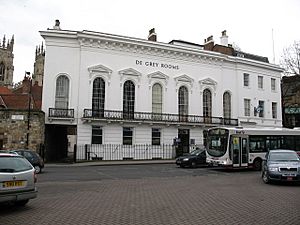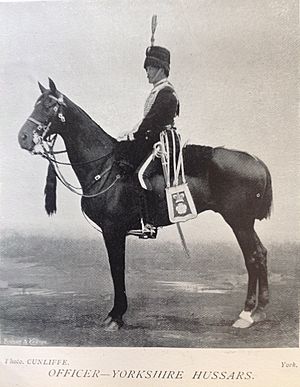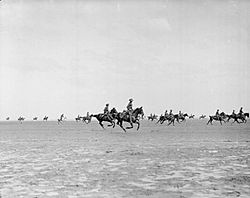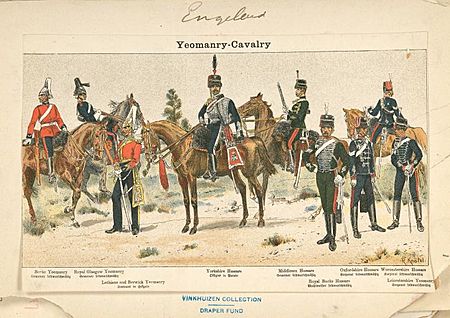Yorkshire Hussars facts for kids
Quick facts for kids Yorkshire Hussars (Alexandra, Princess of Wales's Own) |
|
|---|---|
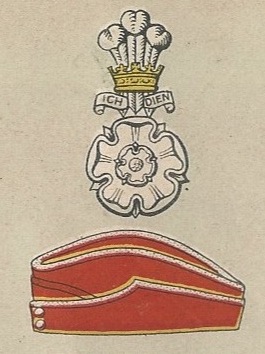
Badge and service cap as worn at the outbreak of the Second World War
|
|
| Active | 13 August 1794 – 1 November 1956 |
| Country | |
| Branch | |
| Type | Yeomanry |
| Size | 1–3 Regiments |
| Garrison/HQ | York |
| Engagements | Second Boer War First World War |
| Battle honours | See below |
The Yorkshire Hussars (Alexandra, Princess of Wales's Own) was a special part of the British Army. It was created in 1794. This group was made up of volunteer cavalry, known as Yeomanry. They served in important wars like the Second Boer War and the First World War. During the Second World War, they changed to using tanks and armoured vehicles. In 1956, the Yorkshire Hussars joined with two other groups from Yorkshire. They formed a new unit called the Queen's Own Yorkshire Yeomanry. Today, their history is carried on by the Queen's Own Yeomanry.
Contents
How the Yorkshire Hussars Began
In 1794, Britain was fighting in the French Revolutionary Wars. The Prime Minister, William Pitt the Younger, suggested that each county should form a group of volunteer cavalry. These groups, called Yeomanry, would help defend the country from invasion. They could also help if there was trouble inside the county.
On August 13, 1794, two regiments of Yeomanry Cavalry were formed in Yorkshire. The 2nd Regiment, which included troops from North Yorkshire, later became the Yorkshire Hussars. Each regiment started with five groups of 50 men.
Early Years and Changes
After a short period of peace in 1802, most Yeomanry groups were disbanded. However, three troops of the Northern Regiment decided to continue serving. More troops joined them in 1803.
Even though the threat of French invasion lessened, there was still unrest in Britain. In 1812, the regiment was ready to help stop the Luddite riots. In 1814, the troops were reorganized. They were based in places like Harewood, Otley, and Ripon.
The 19th Century: A Time of Change
After the French wars ended, the Yeomanry became less important. But the Yorkshire Hussars continued to serve in industrial Yorkshire. In 1819, the Northern Regiment of West Riding Yeomanry was renamed the Yorkshire Hussar Regiment of Yeomanry Cavalry.
The regiment was called upon several times to help keep order. This included during the riots of 1826 and the Chartist troubles of 1842. During the 1842 events, a troop had to charge a crowd in Cleckheaton.
By 1855, the regiment's troops were spread out in different towns. These included Knaresborough, York, and Leeds.
In 1864, the regiment was given a special title: Princess of Wales's Own. This was in honor of Alexandra, Princess of Wales.
In 1871, the number of troops was reduced to eight. Each troop had a permanent staff instructor. In 1875, the regiment received its first modern rifles, called Westley Richards breechloading carbines.
Later in the 1800s, the Yorkshire Hussars, along with other Yorkshire Yeomanry groups, formed the 13th Yeomanry Brigade. In 1898, the regiment officially became the Yorkshire Hussars (Alexandra, Princess of Wales's Own).
Serving as Imperial Yeomanry
The Yeomanry units were not meant to fight outside the United Kingdom. However, during the Second Boer War in South Africa, Britain needed more soldiers, especially mounted ones. In December 1899, the government allowed volunteer forces to serve overseas. This led to the creation of the Imperial Yeomanry (IY).
The Yorkshire Hussars helped form the 9th (Yorkshire (Doncaster)) Company for the Imperial Yeomanry. This company, along with others, formed the 3rd Battalion, IY. The Yorkshire Hussars also helped raise other companies later on.
First Battles in South Africa
The 3rd Battalion IY arrived in South Africa in February 1900. They were the first Imperial Yeomanry battalion to arrive. On April 5, they fought in the Battle of Boshof. This was the first battle for the new Imperial Yeomanry. Even with little training, they fought bravely. Their commander, Lord Methuen, was very impressed.
Methuen's Column, which included the Yorkshire Hussars, became known as the 'Mobile Marvels'. They marched long distances and fought in many actions. They helped protect the main British army and relieve other trapped units.
Fighting Guerrilla Warfare
The war continued with a lot of guerrilla warfare. The Imperial Yeomanry took part in chasing the Boer forces. Many of the original Yeomanry soldiers returned home after a year of service. New volunteers replaced them. The war ended on May 31, 1902.
For their service in the Boer War, the Yorkshire Hussars earned their first Battle honour: South Africa 1900–02. After the war, all Yeomanry regiments at home were converted into Imperial Yeomanry. They were trained as mounted infantry. The Yorkshire Hussars were renamed the Yorkshire Hussars (Alexandra, Princess of Wales's Own) Imperial Yeomanry in 1903.
Joining the Territorial Force
In 1908, the Imperial Yeomanry became part of the new Territorial Force (TF). The regiment was renamed the Yorkshire Hussars Yeomanry (Alexandra, Princess of Wales's Own). Their main headquarters was at 3 Tower Street, York. They had squadrons (smaller groups of troops) in Leeds, York, Knaresborough, and Middlesbrough.
The regiment was part of the Yorkshire Mounted Brigade. This brigade also included the Queen's Own Yorkshire Dragoons and the East Riding of Yorkshire Yeomanry.
The First World War (1914-1918)
Getting Ready for War
When war was declared on August 4, 1914, the regiment got ready for action. They were commanded by Lt-Col Edwin Wilfrid Stanyforth. They guarded the East Yorkshire coast.
The Territorial Force was originally for home defense. But after the war started, units were asked to volunteer for service overseas. Many men volunteered. This led to the creation of "2nd Line" units, which were duplicates of the original units. These 2nd Line units trained new volunteers.
The 1st Line Yorkshire Hussars in Action
The 1st Line of the Yorkshire Hussars spent the winter of 1914–15 in Essex. However, the brigade was soon broken up. Its squadrons were sent to join different infantry divisions.
- B Squadron joined the 46th (North Midland) Division in France in February 1915. They fought in battles like the Hohenzollern Redoubt.
- A Squadron joined the 50th (Northumbrian) Division in April 1915. They fought dismounted (on foot) in the Second Battle of Ypres.
- C Squadron joined the 49th (West Riding) Division in April 1915. They helped hold the front line.
- The machine gun section joined the Essex Yeomanry. They later became part of the 8th Machine Gun Squadron. They remained mounted (on horseback) throughout the war. They fought in the Battle of the Somme and the Battle of Arras.
The three squadrons were reunited in May 1916. They became the Corps Cavalry for XVII Corps in the Arras area.
Becoming Infantry: 9th (Yorkshire Hussars Yeomanry) West Yorkshire Regiment
In August 1917, the 1st Line Yorkshire Hussars were dismounted. They were sent to train as infantry soldiers. In November 1917, the regiment joined the 9th Battalion of the Prince of Wales's Own (West Yorkshire Regiment). This battalion had fought bravely in Gallipoli and on the Western Front.
The 400 men of the Yorkshire Hussars joined the 9th West Yorks. The combined battalion was renamed 9th (Yorkshire Hussars Yeomanry) Bn. They kept their Yeomanry cap badges. Their first action was a successful raid near Lens.
In August 1918, the 11th Division, which included the 9th (YHY) Bn, took part in the Hundred Days Offensive. This was a major Allied attack. They fought in the Second Battle of Arras and the battles of the Hindenburg Line.
During the Battle of the Canal du Nord in September 1918, the battalion attacked and captured the village of Épinoy. They continued to advance, clearing enemy positions.
In the Battle of Cambrai in October, the battalion advanced and cleared the Scheldt canal.
The battalion continued to advance in November. They faced heavy fighting near Roisin, suffering many casualties. On November 6, they attacked again. The advance was rapid. By November 11, 1918, when the Armistice with Germany ended the war, the 11th Division was on high ground.
The battalion spent the winter in billets near Valenciennes. In 1919, soldiers began to return home. The last group of the 9th (YHY) Battalion was disbanded in 1920.
The 9th (Yorkshire Hussars Yeomanry) Bn earned most of the Yorkshire Hussars' battle honors for the First World War. These included France and Flanders 1915–1918.
The 2nd Line Yorkshire Hussars
The 2nd Line regiment was formed in 1914. In 1915, it was part of the 2/1st Yorkshire Mounted Brigade in Yorkshire. In 1916, most 2nd Line yeomanry units were changed to cyclists. The regiment became part of the 11th Cyclist Brigade.
In 1918, the brigade moved to Ireland. The regiment was stationed in Fermoy, County Cork. The regiment was disbanded on December 12, 1919.
Between the World Wars
After the First World War, the regiment was reformed as a cavalry unit with horses in 1920. A group decided that only the 14 oldest Yeomanry regiments would remain as cavalry. The others would become armoured cars, artillery, or signals units. As one of the oldest regiments, the Yorkshire Hussars kept its horses.
The Second World War (1939-1945)
The regiment was ready for service in September 1939. It was part of the 5th Cavalry Brigade. In January 1940, they left the UK and traveled to Palestine.
Becoming an Armoured Regiment
In October 1940, the regiment became a mechanized cavalry unit. This meant they started using vehicles instead of horses. In April 1941, they officially joined the Royal Armoured Corps (RAC). They began training to become an armoured regiment, using M3 Stuart tanks.
In March 1942, the regiment was in Cyprus. They used Valentine tanks and old Cruiser A13 tanks. In March 1943, they moved back to Egypt. They trained with Crusader and Sherman tanks for the North African Campaign.
In November 1943, the regiment returned to the UK. They were changed to an infantry reconnaissance role. This meant they used armoured cars like the Humber Armoured Car and Universal Carriers to scout ahead. They joined the 61st Infantry Division. This division stayed in the UK during the war.
From April to August 1944, parts of the regiment helped run camps for soldiers going to the D Day landings in Normandy. After the war in Europe ended, the Yorkshire Hussars went back to being an armoured unit with Churchill tanks. They were put into "suspended animation" in March 1946, meaning they were temporarily inactive.
After the Wars
When the Territorial Army was reformed in 1947, the Yorkshire Hussars became an armoured regiment again. Their headquarters was in York, with squadrons in Leeds, York, and Middlesbrough.
On November 1, 1956, the Yorkshire Hussars, Yorkshire Dragoons, and East Riding Yeomanry joined together. They formed The Queen's Own Yorkshire Yeomanry.
In 1967, the regiment was disbanded. However, it was reformed as an infantry unit. In 1971, it was reformed again as 'Y' Squadron, which is now 'A' Squadron, of The Queen's Own Yeomanry. This means the history of the Yorkshire Hussars continues today.
Uniforms and Badges
The early uniforms in 1794 were scarlet coats with green collars and cuffs. They wore white breeches and black boots. The officers had silver fringed epaulettes. Their hats were 'round hats' with a bearskin crest.
Later, in 1795, they got new, shorter red jackets and 'Tarleton' light cavalry helmets. In 1803, they went back to red jackets for formal wear, with yellow cuffs and collars.
After the regiment became Hussars in 1819, their uniforms changed to match the Hussar style. By 1852, their full dress uniform was dark blue with white braiding. In 1856, the shako (a tall, stiff military hat) was replaced by a Hussar Busby (a fur hat). This uniform stayed mostly the same for 60 years.
When Alexandra, Princess of Wales, gave her name to the regiment in 1863, they adopted a new cap badge. It featured the Prince of Wales's feathers over the White Rose of York. They kept this badge until 1956.
After becoming Imperial Yeomanry, they wore the standard khaki uniform with red piping. They also wore a Slouch hat with a white and red plume. Later, a peaked cap was adopted, scarlet for officers and khaki for other ranks.
Battle Honours
The Yorkshire Hussars earned several battle honours for their service. These are special awards that show where a unit fought bravely. The honors listed in bold were displayed on the regiment's flag.
| Second Boer War | South Africa 1900–02 |
| First World War | Arras 1918, Scarpe 1918, Drocourt-Quéant, Hindenburg Line, Canal du Nord, Cambrai 1918, Selle, Sambre, France and Flanders 1915–18 |
Even though the regiment served overseas in the Second World War, it did not receive any battle honors for that conflict.
Images for kids


